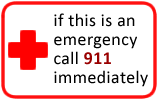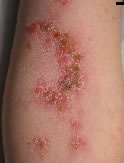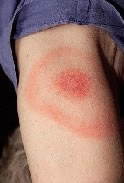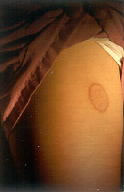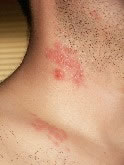Rash - Localized and Cause Unknown
Rash - Localized and Cause Unknown
Does this describe your symptoms? |
Click image for more info |
Definition
Includes:
General Information
Contact Dermatitis Contact dermatitis is a common cause of persistent localized rashes. Contact dermatitis usually presents as localized raised red spots. Occasionally it progresses to localized blisters (e.g., poison ivy. Contact dermatitis only occurs after repeated contacts with the allergic substance. Once sensitized to a substance, however, reactions occur 12 to 24 hours after exposure. The location of the rash may suggest the cause.
Intertrigo
|
If not, see these topics
|
When to Call Your Doctor |
Call Your Doctor Now (night or day) If |
|
|
|
Call Your Doctor Within 24 Hours (between 9 am and 4 pm) If |
|
|
|
Call Your Doctor During Weekday Office Hours If |
|
|
|
Self Care at Home If |
|
|
HOME CARE ADVICEFOR MILD LOCALIZED RASH |
General Care Advice for Mild Localized Rash
Avoid the Cause: Try to find the cause. Consider irritants like a plant (e.g., poison ivy or evergreens), chemicals (e.g., solvents or insecticides), fiberglass, a new cosmetic, or new jewelry (called contact dermatitis). A pet may be carrying the irritating substance (e.g., with poison ivy or poison oak).
Avoid Soap: Wash the area once thoroughly with soap to remove any remaining irritants. Thereafter avoid soaps to this area. Cleanse the area when needed with warm water.
Local Cold: Apply or soak in cold water for 20 minutes every 3 to 4 hours to reduce itching or pain.
Hydrocortisone Cream for Itching: If the itch is more than mild, apply 1% hydrocortisone cream 4 times a day to reduce itching. Use it for 5 days.
Keep the cream in the refrigerator (Reason: it feels better if applied cold).
Available over-the-counter in U.S. as 0.5% and 1% cream.
Available over-the-counter in Canada as 0.5% cream.
CAUTION: Do not use hydrocortisone cream on suspected Athlete's Foot, Jock Itch, ringworm, or impetigo.
Avoid Scratching: Try not to scratch. Cut your fingernails short.
Contagiousness: Adults with localized rashes do not need to miss any work or school.
Expected Course: Most of these rashes pass in 2 to 3 days.
Call Your Doctor If:
Rash spreads or becomes worse
Rash lasts longer than 1 week
You develop any of the "Call Your Doctor" symptoms.
General Care Advice for Pimples
Reassurance: A pimple is a tiny, superficial infection without any redness. Pimples can occur with acne or friction.
Cleansing: Wash the infected area with warm water and an antibacterial soap 3 times a day.
Antibiotic Ointment: Apply an over-the-counter antibiotic ointment to the infected area 3 times per day.
Call Your Doctor If:
Redness occurs
Fever occurs
More pimples occur
You develop any of the "Call Your Doctor" symptoms.
And remember, contact your doctor if you develop any of the "Call Your Doctor" symptoms.
Updated:
March 22, 2017
